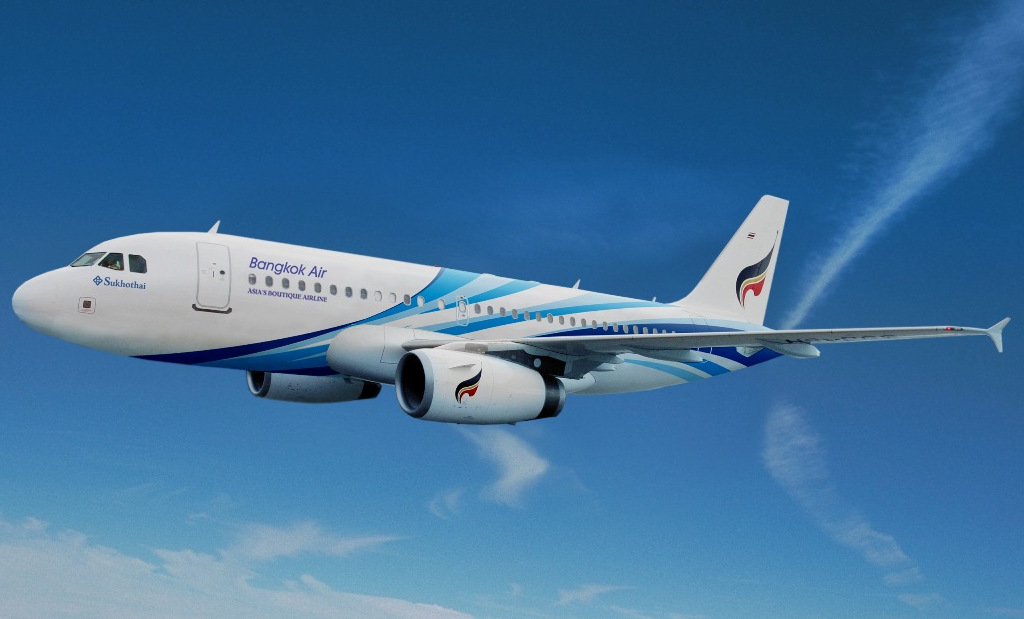Learn the steps for setting up HR Renewal 1.0 in an SAP NetWeaver Standalone Gateway system.
Key Concept
The user interface (UI) development toolkit for HTML5 (commonly known as SAPUI5), is a technology that provides a lightweight programming model for desktop and mobile applications. The SAPUI5 run time is a client-side HTML5 rendering library with a rich set of standard and extension controls. SAP NetWeaver Gateway is a technology that allows desktop and mobile SAPUI5 applications to connect with SAP systems. SAP NetWeaver Gateway uses Open Data (OData) protocol and the REST-based approach to connect client-side applications with SAP systems in a secure way.
HR Renewal 1.0 is developed using SAPUI5 and the content based on SAPUI5 requires SAP NetWeaver Gateway. SAP NetWeaver Gateway is a development framework, which is available as an SAP NetWeaver Application Server ABAP (AS ABAP) add-on, which you can install on top of your existing SAP Business Suite or application platform. SAP NetWeaver Gateway connects SAPUI5 to the SAP system’s back end (e.g., SAP ERP Central Component [ECC]) securely. The HR Renewal 1.0 deployment options are outlined in Figure 1.
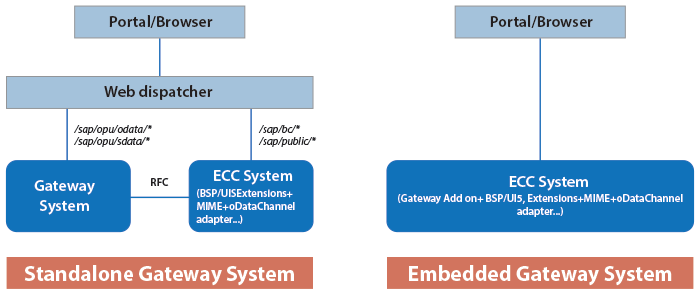
Figure 1
The SAP NetWeaver Standalone Gateway system versus the Embedded Gateway system
Methods for Installing SAP NetWeaver Gateway
There are two different ways for installing SAP NetWeaver Gateway in the servers:
- The SAP NetWeaver Gateway can be installed on a dedicated server (referred as Standalone Gateway system or Central Hub deployment).
- The SAP NetWeaver Gateway can be installed on the same server where the SAP Business Suite or SAP ECC system resides (referred as SAP Embedded Gateway system or embedded deployment).
To learn more about the deployments options of the Standalone Gateway system and the Embedded Gateway system, follow this link: Standalone and Embedded Gateway deployment options.
We as a company preferred the Standalone Gateway system because we have multiple SAP back-end systems (SAP ECC, CRM, and SRM) and did not want to have to install the SAP NetWeaver Gateway system on every individual system, which would result in duplicated activity. We also felt support and maintenance activities would be costly. Moreover, overhead costs increase if you want to upgrade the SAP NetWeaver Gateway system software components on these individual systems every time new features are released by SAP.
Companies can decide what type of Gateway system implementation options they prefer, taking into consideration the benefits that best meet their needs. This main focus of this article is on how the HR Renewal 1.0 solution can be deployed in the SAP system with the help of the Standalone Gateway system.
Setting Up HR Renewal 1.0 in a Standalone Gateway System
In this section, I discuss how I deployed the HR Renewal 1.0 in a Standalone Gateway system. In this setup, all of the SAPUI5 applications are running in the SAP back-end system and the OData services are registered in the Standalone Gateway system. As mentioned previously, SAP NetWeaver Gateway uses the Open Data (OData) protocol service to connect the SAPUI5 applications with the back end data in a secure way. HR Renewal 1.0 provides standard OData services for all the SAPUI5 applications. A list of the available OData services is shown in Table 1.
OData services
|
| /UI2/PAGE_BUILDER_CUST |
| /UI2/PAGE_BUILDER_PERS |
| /UI2/PAGE_BUILDER_CONF |
| HRESS_EMP_LANE_PROF_SERVICE |
| HRESS_EMP_WORK_FEEDS_SERVICE |
| HRESS_WRK_FEED_SUB_OVERVIEW_SERVICE |
| HRESS_EMP_PROFILE_SERVICE |
| HRESS_EMP_LSO_SERVICE |
| HRESS_PAYSLIP_SERVICE |
| HRESS_LEAVE_REQUEST_SERVICE |
| HRESS_TEAM_CALENDAR_SERVICE |
| PAO_SEARCH_SERVICE |
| /IWFND/NOTIFICATIONSTORE |
| /UI2/LAUNCHPAD |
| HRESS_EMP_WORK_FEEDS_SERVICE |
| HROVIS_ORGCHART_SERVICE |
| HRXSS_PERNR_MEMID_SERVICE |
| HRXSS_PERS_KEY |
| HRMSS_OTHER_APPROVALS_SERVICE |
| HRMSS_LEAVE_APPROVAL_SERVICE |
| HRESS_TEAM_CALENDAR_SERVICE |
| HRESS_EMP_PROFILE_SERVICE |
| HRMSS_EMPLOYEE_NOTES_SERVICE |
| PAO_ACTIONMENU |
| /IWFND/NOTIFICATIONSTORE |
| PAO_STREAMWORK |
| PAO_ACTIONMENU |
| PAO_PROCESSES |
| PAO_USERCONTEXT |
| PAO_ORGANIZATION_FAVORITES |
| /IWPGW/TASKPROCESSING |
| HRGEN_QUICK_VIEW_SERVICE |
| PAO_ACTIONMENU |
| UI2/QUICKVIEW |
Table 1
A list of available HR Renewal 1.0 OData services
Register the OData Services in an SAP Standalone Gateway System
The content for the landing page is provided by the OData Services. In this article, I walk through how you can register the OData services for the Manager Self-Service (MSS) SAPUI5 applications. The relevant OData service information for the MSS scenario can be found via the following link: OData information.
The SAPUI5 applications relevant to the MSS scenario are as follows:
- HRMSS_MYTEAM_G
- HRMSS_TASKS_G
- HRESS_WRKFEED_G
- HRMSS_TEAMSRV_G
- HRMSS_TEAMCDR_G
- HRMSS_LR_APPR_G
- HRESS_EMP_PRO_G
- HRMSS_MGRANA_G
- HRMSS_LPD_C
- HRMSSATTACH
Log in to the SAP NetWeaver Standalone Gateway system and execute transaction code /IWFND/MAINT_SERVICE to open the Activate and Maintain services screen (Figure 2).
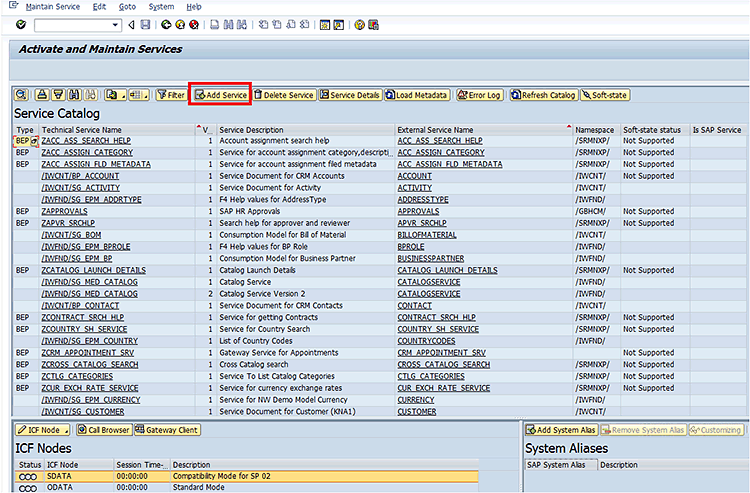
Figure 2
Open the Activate and Maintain Services screen to add the new service
Click the Add Service button and the screen in Figure 3 opens.
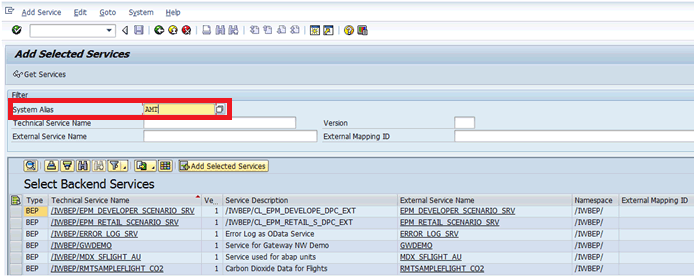
Figure 3
Add selected services
Using the right-click Help option in the System Alias field, choose the SAP back-end system (in this case, AMT). Once the System Alias name is selected, click the Get Services button (Figure 3) and a screen opens that displays all the OData services available in the corresponding SAP back-end system (Figure 4). These MSS-related OData services are the same ones as listed in Table 1. (Not all of the MSS OData services are shown in the figure—just some of the options, which are highlighted with a red box).

Figure 4
Examples of MSS-related OData services
Note
The System Alias connects the SAP back-end system to where the OData
services are available, and the SAP Standalone Gateway system registers
the OData services from the SAP back-end with the help of the System
Alias. The System Alias is defined in the configuration. To define the
System Alias, select the appropriate software version and follow SPRO
menu path > SAP Netweaver> Gateway > OData Channel >
Configuration > Connection Settings > SAP Netweaver Gateway to SAP
System > Manage SAP System Aliases.
In the screen that opens (not shown) click the execute icon  and the screen shown in Figure 5 opens. Here you can define the SAP System Alias and maintain the Remote Function Call (RFC) destination for your SAP back-end systems by clicking the New Entries button. After defining the SAP System Alias information, click the save icon
and the screen shown in Figure 5 opens. Here you can define the SAP System Alias and maintain the Remote Function Call (RFC) destination for your SAP back-end systems by clicking the New Entries button. After defining the SAP System Alias information, click the save icon  to save the configuration entries. This takes you back to the screen in Figure 3.
to save the configuration entries. This takes you back to the screen in Figure 3.

Figure 5
Define the SAP System Alias
In this example (Figure 6), select the HRMSS_EMPLOYEE_NOTES_SERVICE OData service in the Standalone Gateway system and click the Add Selected Services button.
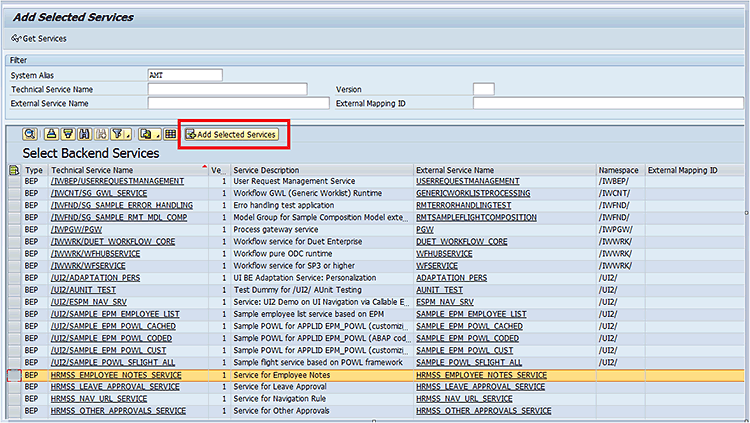
Figure 6
Select the MSS-related OData service
This opens the pop-up window in Figure 7. The Technical Service Name and the Technical Model Names are filled by default by the standard SAP system.

Figure 7
Add the service
Select the Package Assignment if you want to move the registered service as an SAP transport request to a different SAP landscape (e.g., an SAP development, SAP Quality, or SAP production system). In this example, I chose Local Object. Then click the green checkmark icon  in the bottom right of the screen. This opens another pop-up screen with the message Service 'HRMSS_EMPLOYEE_NOTES_SERVICE' was created and its metadata was loaded successfully (Figure 8). Click the green checkmark icon in this window to confirm the action, which takes you back to the screen in Figure 9. Then click the back icon to see the registered service (Figure 10).
in the bottom right of the screen. This opens another pop-up screen with the message Service 'HRMSS_EMPLOYEE_NOTES_SERVICE' was created and its metadata was loaded successfully (Figure 8). Click the green checkmark icon in this window to confirm the action, which takes you back to the screen in Figure 9. Then click the back icon to see the registered service (Figure 10).
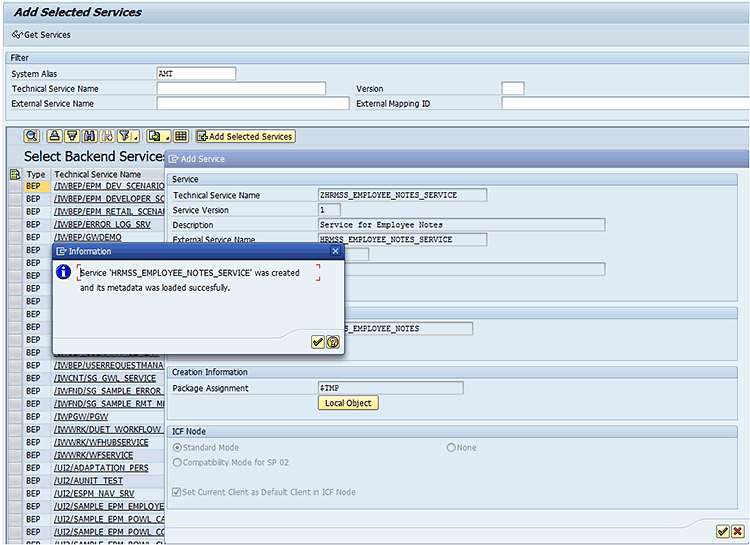
Figure 8
Confirmation that the service and metadata were successfully loaded

Figure 9
Click the back icon to see the new MSS service

Figure 10
Check the registered MSS-related OData service
Back in the Activate and Maintain Service screen (Figure 10) you can see the registered MSS OData service listed in the Service Catalog. Double-click the service and the registered OData service and the System Alias information appear in the bottom of the screen (under ICF Nodes and System Aliases, respectively). Follow these same steps to register all of the HR Renewal 1.0-related OData services (listed in Table 1) in the same way.
Configure the SAP Services
In order to make HR Renewal work, you need to activate the Business Server page (BSP) and HTTP services. These services can be activated by executing transaction code SICF. To see a list of available services and how to activate them for HR Renewal 1.0, follow these links:
Employee Self-Services: List of available ESS services and how to activate them for HR Renewal 1.0.
Manager Self-Services: List of available MSS services and how to activate them for HR Renewal 1.0.
Workforce Viewer: List of available Workforce Viewer services and how to activate them for HR Renewal 1.0.
Landing pages: List of available landing page services and how to activate them for HR Renewal 1.0.
If the ABAP back-end system has a different client number than the SAP Standalone Gateway system, you need to perform some additional steps. Follow this link for directions about what you need to do: SAP ABAP Help.
SAP Web Dispatcher Configurations
Web Dispatcher is the entry point for HTTP(s) requests into your system, which consists of one or more SAP NetWeaver application servers. Web Dispatcher acts as a software web switch and it can reject or accept connections. In this example, SAP Web Dispatcher re-directs the OData calls to the SAP Standalone Gateway system and the rest of the calls to the SAP back-end system. (Note, in this case, SAP Web Dispatcher version 7.41 was implemented.)
To learn more about SAP Web Dispatcher, follow this link: Read about Web Dispatcher.
Since HR Renewal 1.0 is deployed along with SAP NetWeaver Standalone Gateway system, as mentioned before, the SAPUI5 applications as BSP services reside in the SAP back-end system, and all of the OData services are registered in the Standalone Gateway system.
The SAP Web Dispatcher code shown in Figure 11 re-directs the OData service calls to the SAP NetWeaver Standalone Gateway system, and the remaining service calls to the SAP back-end system.
wdisp/system_conflict_resolution = 1
wdisp/handle_webdisp_ap_header = 1
wdisp/add_clientprotocol_header = 1
wdisp/add_xforwardedfor_header = true
wdisp/system_0 = SID=GWD, MSHOST=gateway.edu.sa, MSPORT=8101, SRCSRV=dispatcher.edu.sa:8000, SRCURL=/sap/opu/odata/;/sap/opu/sdata/
wdisp/system_1 = SID=GWD, MSHOST=gateway.edu.sa, MSPORT=8101, SRCSRV=dispatcher.edu.sa:443, SRCURL=/sap/opu/odata/;/sap/opu/sdata/
wdisp/system_2 = SID=AMT, MSHOST=backend.edu.sa, MSPORT=8100, SRCSRV=dispatcher.edu.sa:8000, SRCURL=/sap/
wdisp/system_3 = SID=AMT, MSHOST=backend.edu.sa, MSPORT=8100, SRCSRV=dispatcher.edu.sa:443, SRCURL=/sap/
Figure 11
Code to re-direct service calls to the appropriate systems
To learn more about the SAP Web Dispatcher configuration, follow this link: Learn more about the configuration of Web Dispatcher.
Now let’s construct the Web Dispatcher URL. The Web Dispatcher rule (Figure 11) is in the Web Dispatcher with the server name dispatcher.edu.sa and the port 8000. The URL for the HR Renewal 1.0 landing page URL then becomes: https://dispatcher.edu.sa:8000/sap/bc/ui5_ui5/sap/ARSRVC_SUITE_PB/main.html?page=HR_SELFSERVICES.
When this URL is called, the SAP Web Dispatcher listens at port 8000 and transfers all of the requests that start with /sap/opu/odata/ or sap/opu/sdata to the SAP NetWeaver Standalone Gateway system and directs all requests that start with /sap/ to the back-end system. In the Web Dispatcher rule shown in Figure 11, I have written the rules for both HTTP and HTTPS service calls.
Figure 12 shows an example of an HR Renewal 1.0 landing page with the MSS role called using the Web Dispatcher URL.

Figure 12
An example of an MSS landing page
Rajkumar Shanmuganathan
Rajkumar Shanmuganathan is a freelance SAP Lead Technical Consultant. He has worked in SAP for over 10 years, seven of which he focused on SAP HCM as a techno-functional consultant on several international projects. He is SAP-certified in ABAP, CRM, and SAP HANA, and currently is working projects that involve new SAP technologies, such as SAPUI5, SAP Gateway, and SAP Fiori. Rajkumar regularly shares his knowledge in the SAP SDN/SCN forum. You can view his blog posts by following this link: https://scn.sap.com/people/rajkumar.shanmuganathan3/content.
You may contact the author at ssrajkumar2004@gmail.com.
If you have comments about this article or publication, or would like to submit an article idea, please contact the editor.













